Brand Equity and Consumer Behavior
VerifiedAdded on 2020/02/05
|14
|4265
|103
Literature Review
AI Summary
This assignment delves into the crucial relationship between brand equity and consumer behavior. Students are tasked with analyzing various aspects, including the effectiveness of brand extensions, the role of private branding in enhancing service quality, and the influence of corporate social responsibility (CSR) communication on business returns. The assignment encourages critical thinking about how brands build value and shape consumer perceptions.
Contribute Materials
Your contribution can guide someone’s learning journey. Share your
documents today.

“TO WHAT EXTENT DOES BRAND IDENTITY AFFECT BRAND LOYALTY? USE AN
APPROPRIATE BRAND IDENTITY MODEL TO AID YOUR ANALYSIS.”
APPROPRIATE BRAND IDENTITY MODEL TO AID YOUR ANALYSIS.”
Secure Best Marks with AI Grader
Need help grading? Try our AI Grader for instant feedback on your assignments.
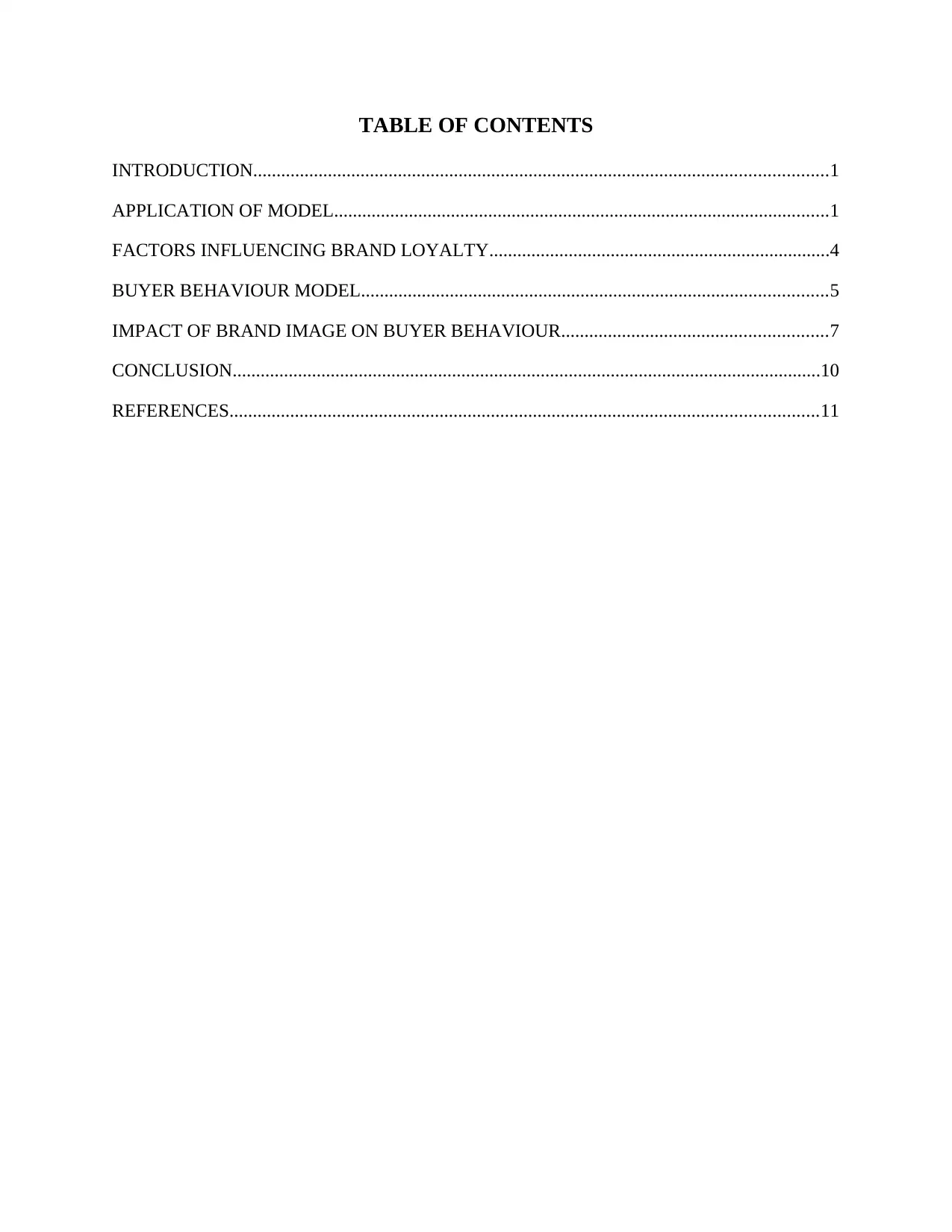
TABLE OF CONTENTS
INTRODUCTION...........................................................................................................................1
APPLICATION OF MODEL..........................................................................................................1
FACTORS INFLUENCING BRAND LOYALTY.........................................................................4
BUYER BEHAVIOUR MODEL....................................................................................................5
IMPACT OF BRAND IMAGE ON BUYER BEHAVIOUR.........................................................7
CONCLUSION..............................................................................................................................10
REFERENCES..............................................................................................................................11
INTRODUCTION...........................................................................................................................1
APPLICATION OF MODEL..........................................................................................................1
FACTORS INFLUENCING BRAND LOYALTY.........................................................................4
BUYER BEHAVIOUR MODEL....................................................................................................5
IMPACT OF BRAND IMAGE ON BUYER BEHAVIOUR.........................................................7
CONCLUSION..............................................................................................................................10
REFERENCES..............................................................................................................................11
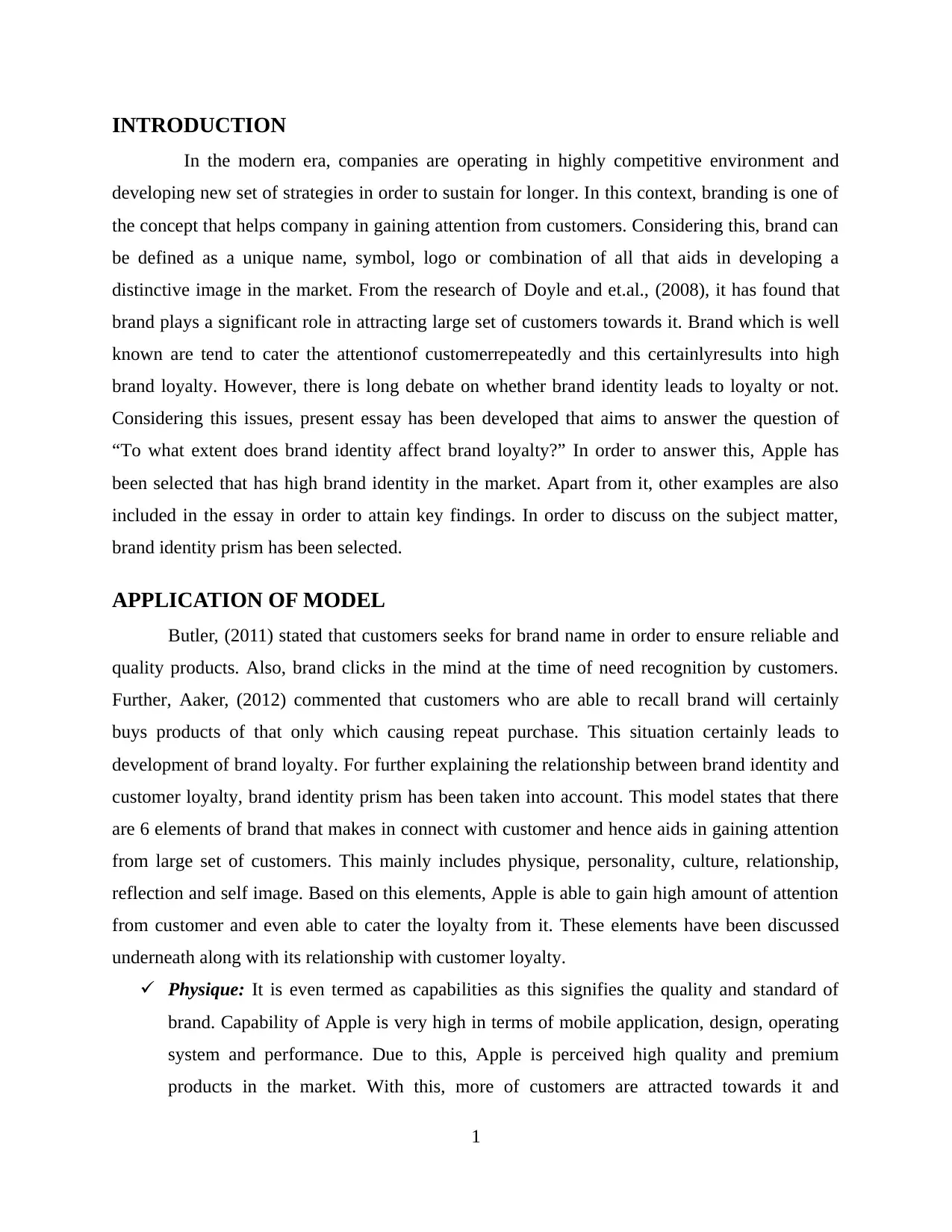
INTRODUCTION
In the modern era, companies are operating in highly competitive environment and
developing new set of strategies in order to sustain for longer. In this context, branding is one of
the concept that helps company in gaining attention from customers. Considering this, brand can
be defined as a unique name, symbol, logo or combination of all that aids in developing a
distinctive image in the market. From the research of Doyle and et.al., (2008), it has found that
brand plays a significant role in attracting large set of customers towards it. Brand which is well
known are tend to cater the attentionof customerrepeatedly and this certainlyresults into high
brand loyalty. However, there is long debate on whether brand identity leads to loyalty or not.
Considering this issues, present essay has been developed that aims to answer the question of
“To what extent does brand identity affect brand loyalty?” In order to answer this, Apple has
been selected that has high brand identity in the market. Apart from it, other examples are also
included in the essay in order to attain key findings. In order to discuss on the subject matter,
brand identity prism has been selected.
APPLICATION OF MODEL
Butler, (2011) stated that customers seeks for brand name in order to ensure reliable and
quality products. Also, brand clicks in the mind at the time of need recognition by customers.
Further, Aaker, (2012) commented that customers who are able to recall brand will certainly
buys products of that only which causing repeat purchase. This situation certainly leads to
development of brand loyalty. For further explaining the relationship between brand identity and
customer loyalty, brand identity prism has been taken into account. This model states that there
are 6 elements of brand that makes in connect with customer and hence aids in gaining attention
from large set of customers. This mainly includes physique, personality, culture, relationship,
reflection and self image. Based on this elements, Apple is able to gain high amount of attention
from customer and even able to cater the loyalty from it. These elements have been discussed
underneath along with its relationship with customer loyalty.
Physique: It is even termed as capabilities as this signifies the quality and standard of
brand. Capability of Apple is very high in terms of mobile application, design, operating
system and performance. Due to this, Apple is perceived high quality and premium
products in the market. With this, more of customers are attracted towards it and
1
In the modern era, companies are operating in highly competitive environment and
developing new set of strategies in order to sustain for longer. In this context, branding is one of
the concept that helps company in gaining attention from customers. Considering this, brand can
be defined as a unique name, symbol, logo or combination of all that aids in developing a
distinctive image in the market. From the research of Doyle and et.al., (2008), it has found that
brand plays a significant role in attracting large set of customers towards it. Brand which is well
known are tend to cater the attentionof customerrepeatedly and this certainlyresults into high
brand loyalty. However, there is long debate on whether brand identity leads to loyalty or not.
Considering this issues, present essay has been developed that aims to answer the question of
“To what extent does brand identity affect brand loyalty?” In order to answer this, Apple has
been selected that has high brand identity in the market. Apart from it, other examples are also
included in the essay in order to attain key findings. In order to discuss on the subject matter,
brand identity prism has been selected.
APPLICATION OF MODEL
Butler, (2011) stated that customers seeks for brand name in order to ensure reliable and
quality products. Also, brand clicks in the mind at the time of need recognition by customers.
Further, Aaker, (2012) commented that customers who are able to recall brand will certainly
buys products of that only which causing repeat purchase. This situation certainly leads to
development of brand loyalty. For further explaining the relationship between brand identity and
customer loyalty, brand identity prism has been taken into account. This model states that there
are 6 elements of brand that makes in connect with customer and hence aids in gaining attention
from large set of customers. This mainly includes physique, personality, culture, relationship,
reflection and self image. Based on this elements, Apple is able to gain high amount of attention
from customer and even able to cater the loyalty from it. These elements have been discussed
underneath along with its relationship with customer loyalty.
Physique: It is even termed as capabilities as this signifies the quality and standard of
brand. Capability of Apple is very high in terms of mobile application, design, operating
system and performance. Due to this, Apple is perceived high quality and premium
products in the market. With this, more of customers are attracted towards it and
1
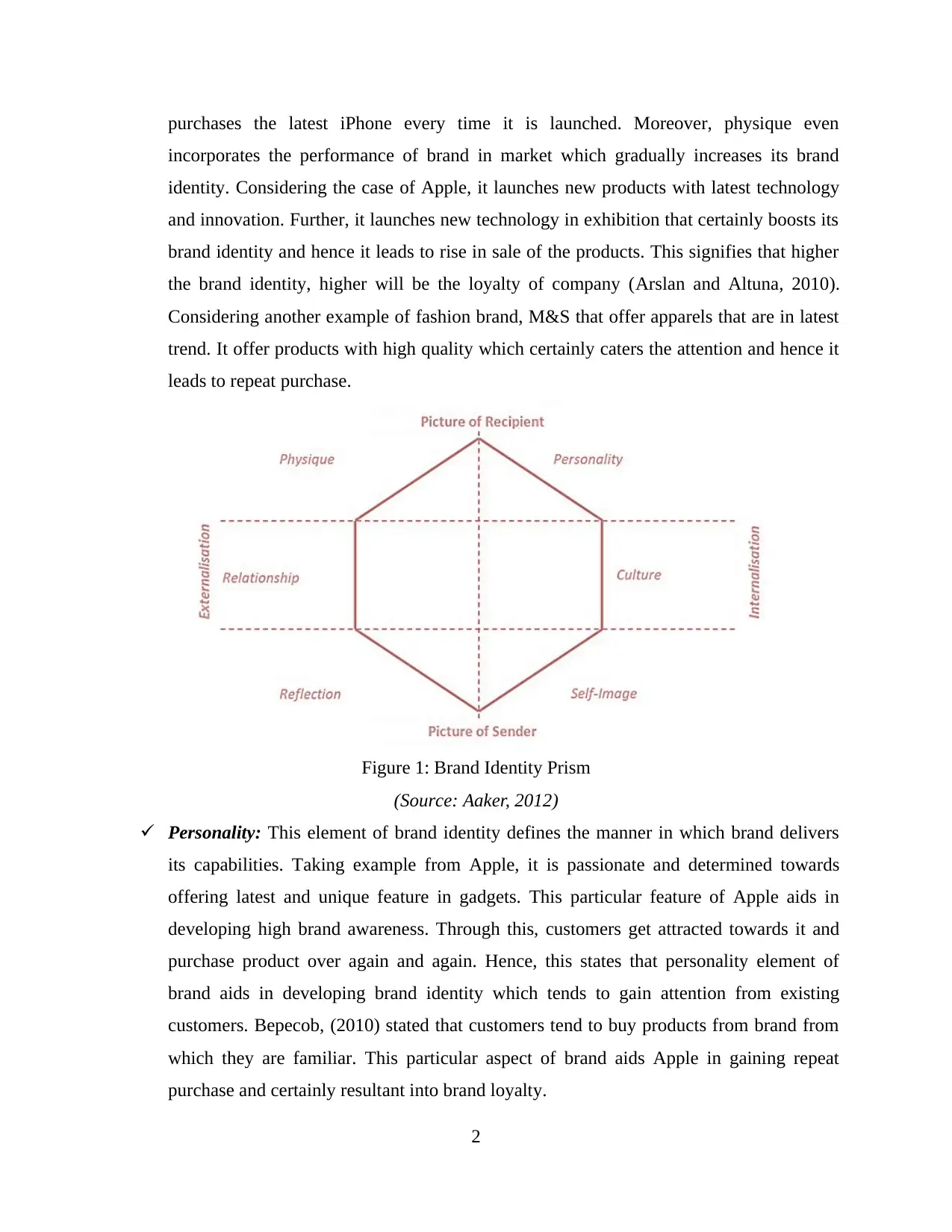
purchases the latest iPhone every time it is launched. Moreover, physique even
incorporates the performance of brand in market which gradually increases its brand
identity. Considering the case of Apple, it launches new products with latest technology
and innovation. Further, it launches new technology in exhibition that certainly boosts its
brand identity and hence it leads to rise in sale of the products. This signifies that higher
the brand identity, higher will be the loyalty of company (Arslan and Altuna, 2010).
Considering another example of fashion brand, M&S that offer apparels that are in latest
trend. It offer products with high quality which certainly caters the attention and hence it
leads to repeat purchase.
Figure 1: Brand Identity Prism
(Source: Aaker, 2012)
Personality: This element of brand identity defines the manner in which brand delivers
its capabilities. Taking example from Apple, it is passionate and determined towards
offering latest and unique feature in gadgets. This particular feature of Apple aids in
developing high brand awareness. Through this, customers get attracted towards it and
purchase product over again and again. Hence, this states that personality element of
brand aids in developing brand identity which tends to gain attention from existing
customers. Bерecob, (2010) stated that customers tend to buy products from brand from
which they are familiar. This particular aspect of brand aids Apple in gaining repeat
purchase and certainly resultant into brand loyalty.
2
incorporates the performance of brand in market which gradually increases its brand
identity. Considering the case of Apple, it launches new products with latest technology
and innovation. Further, it launches new technology in exhibition that certainly boosts its
brand identity and hence it leads to rise in sale of the products. This signifies that higher
the brand identity, higher will be the loyalty of company (Arslan and Altuna, 2010).
Considering another example of fashion brand, M&S that offer apparels that are in latest
trend. It offer products with high quality which certainly caters the attention and hence it
leads to repeat purchase.
Figure 1: Brand Identity Prism
(Source: Aaker, 2012)
Personality: This element of brand identity defines the manner in which brand delivers
its capabilities. Taking example from Apple, it is passionate and determined towards
offering latest and unique feature in gadgets. This particular feature of Apple aids in
developing high brand awareness. Through this, customers get attracted towards it and
purchase product over again and again. Hence, this states that personality element of
brand aids in developing brand identity which tends to gain attention from existing
customers. Bерecob, (2010) stated that customers tend to buy products from brand from
which they are familiar. This particular aspect of brand aids Apple in gaining repeat
purchase and certainly resultant into brand loyalty.
2
Secure Best Marks with AI Grader
Need help grading? Try our AI Grader for instant feedback on your assignments.

Culture: As per Aaker and McLoughlin, (2009), culture is an element that connects
brand with potential customers and it is one of the key components in boosting brand
identity. Culture in case of brand includes core beliefs, things brand will never
compromise and value. Considering the example of brand like Apple, Audi and Dell
which possess a culture of offering superior products. For this, cited companies doesn’t
depends upon need of customer, rather it emphasis on developing high quality products
so that need among customers can be generated. Due to this culture, mentioned company
enjoys dominant position in respective industry and also has high brand identity. This
particular factor of culture certainly influences customers and hence it leads to
development of loyalty (Bick, 2009).
Relationship: Connection among brand and customers is required so that they can
associate themselves with brand and hence makes repeat purchase. In this regard, Apple
is able to develop relation with customers by offering them the sense of royal and
premium products. Apple products itself reflects class and feeling of difference from
other which certainly aids in motivating customers to buy product again and again. Brand
identity is further boosted with relationship and by making contact with customers either
interpersonal or from any other manner (Becerra and Badrinarayanan, 2013). Same is the
case with Armani, Gucci etc. Through which overall sales of company gets increased.
Self Image: It is another aspect of brand that makes the feel of difference to customer
while using branded products. Brand like Audi, BMW, Apple, Rolls Royce and other
prominent brand offers sense of difference to customers that certainly make them feel
special. This particular feeling meets with specific need of customers and hence they tend
to buy repeatedly. Hence, self image is one crucial factor that aids in reflecting the
personality of customer through products. Beside this, brand like M&S, Zappos, Sony
etc. gives different perception to others and due to this, customer stick towards one
particular brand (Chen and Liu, 2004). Hence, it states that self image aspect of brand
aids in meeting with diverse needs of customer and this certainly develops loyalty toward
brand
Reflection: Brand identity is even developed from the element of feature which includes
the motive of brand towards welfare of society of humanity. Brand identity gradually
increase with the campaign that been undertaken by company and this aspires customers
3
brand with potential customers and it is one of the key components in boosting brand
identity. Culture in case of brand includes core beliefs, things brand will never
compromise and value. Considering the example of brand like Apple, Audi and Dell
which possess a culture of offering superior products. For this, cited companies doesn’t
depends upon need of customer, rather it emphasis on developing high quality products
so that need among customers can be generated. Due to this culture, mentioned company
enjoys dominant position in respective industry and also has high brand identity. This
particular factor of culture certainly influences customers and hence it leads to
development of loyalty (Bick, 2009).
Relationship: Connection among brand and customers is required so that they can
associate themselves with brand and hence makes repeat purchase. In this regard, Apple
is able to develop relation with customers by offering them the sense of royal and
premium products. Apple products itself reflects class and feeling of difference from
other which certainly aids in motivating customers to buy product again and again. Brand
identity is further boosted with relationship and by making contact with customers either
interpersonal or from any other manner (Becerra and Badrinarayanan, 2013). Same is the
case with Armani, Gucci etc. Through which overall sales of company gets increased.
Self Image: It is another aspect of brand that makes the feel of difference to customer
while using branded products. Brand like Audi, BMW, Apple, Rolls Royce and other
prominent brand offers sense of difference to customers that certainly make them feel
special. This particular feeling meets with specific need of customers and hence they tend
to buy repeatedly. Hence, self image is one crucial factor that aids in reflecting the
personality of customer through products. Beside this, brand like M&S, Zappos, Sony
etc. gives different perception to others and due to this, customer stick towards one
particular brand (Chen and Liu, 2004). Hence, it states that self image aspect of brand
aids in meeting with diverse needs of customer and this certainly develops loyalty toward
brand
Reflection: Brand identity is even developed from the element of feature which includes
the motive of brand towards welfare of society of humanity. Brand identity gradually
increase with the campaign that been undertaken by company and this aspires customers
3
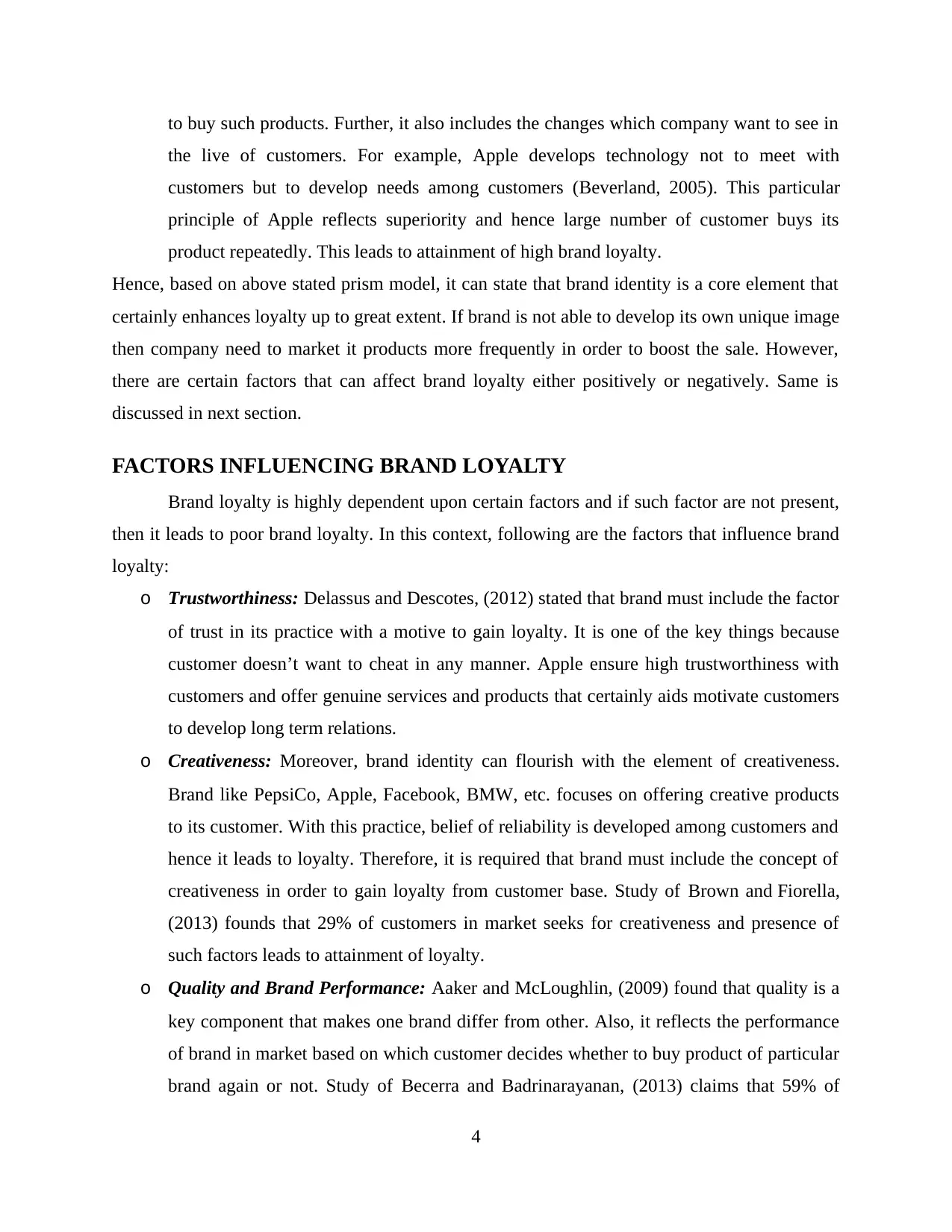
to buy such products. Further, it also includes the changes which company want to see in
the live of customers. For example, Apple develops technology not to meet with
customers but to develop needs among customers (Beverland, 2005). This particular
principle of Apple reflects superiority and hence large number of customer buys its
product repeatedly. This leads to attainment of high brand loyalty.
Hence, based on above stated prism model, it can state that brand identity is a core element that
certainly enhances loyalty up to great extent. If brand is not able to develop its own unique image
then company need to market it products more frequently in order to boost the sale. However,
there are certain factors that can affect brand loyalty either positively or negatively. Same is
discussed in next section.
FACTORS INFLUENCING BRAND LOYALTY
Brand loyalty is highly dependent upon certain factors and if such factor are not present,
then it leads to poor brand loyalty. In this context, following are the factors that influence brand
loyalty:
o Trustworthiness: Delassus and Descotes, (2012) stated that brand must include the factor
of trust in its practice with a motive to gain loyalty. It is one of the key things because
customer doesn’t want to cheat in any manner. Apple ensure high trustworthiness with
customers and offer genuine services and products that certainly aids motivate customers
to develop long term relations.
o Creativeness: Moreover, brand identity can flourish with the element of creativeness.
Brand like PepsiCo, Apple, Facebook, BMW, etc. focuses on offering creative products
to its customer. With this practice, belief of reliability is developed among customers and
hence it leads to loyalty. Therefore, it is required that brand must include the concept of
creativeness in order to gain loyalty from customer base. Study of Brown and Fiorella,
(2013) founds that 29% of customers in market seeks for creativeness and presence of
such factors leads to attainment of loyalty.
o Quality and Brand Performance: Aaker and McLoughlin, (2009) found that quality is a
key component that makes one brand differ from other. Also, it reflects the performance
of brand in market based on which customer decides whether to buy product of particular
brand again or not. Study of Becerra and Badrinarayanan, (2013) claims that 59% of
4
the live of customers. For example, Apple develops technology not to meet with
customers but to develop needs among customers (Beverland, 2005). This particular
principle of Apple reflects superiority and hence large number of customer buys its
product repeatedly. This leads to attainment of high brand loyalty.
Hence, based on above stated prism model, it can state that brand identity is a core element that
certainly enhances loyalty up to great extent. If brand is not able to develop its own unique image
then company need to market it products more frequently in order to boost the sale. However,
there are certain factors that can affect brand loyalty either positively or negatively. Same is
discussed in next section.
FACTORS INFLUENCING BRAND LOYALTY
Brand loyalty is highly dependent upon certain factors and if such factor are not present,
then it leads to poor brand loyalty. In this context, following are the factors that influence brand
loyalty:
o Trustworthiness: Delassus and Descotes, (2012) stated that brand must include the factor
of trust in its practice with a motive to gain loyalty. It is one of the key things because
customer doesn’t want to cheat in any manner. Apple ensure high trustworthiness with
customers and offer genuine services and products that certainly aids motivate customers
to develop long term relations.
o Creativeness: Moreover, brand identity can flourish with the element of creativeness.
Brand like PepsiCo, Apple, Facebook, BMW, etc. focuses on offering creative products
to its customer. With this practice, belief of reliability is developed among customers and
hence it leads to loyalty. Therefore, it is required that brand must include the concept of
creativeness in order to gain loyalty from customer base. Study of Brown and Fiorella,
(2013) founds that 29% of customers in market seeks for creativeness and presence of
such factors leads to attainment of loyalty.
o Quality and Brand Performance: Aaker and McLoughlin, (2009) found that quality is a
key component that makes one brand differ from other. Also, it reflects the performance
of brand in market based on which customer decides whether to buy product of particular
brand again or not. Study of Becerra and Badrinarayanan, (2013) claims that 59% of
4
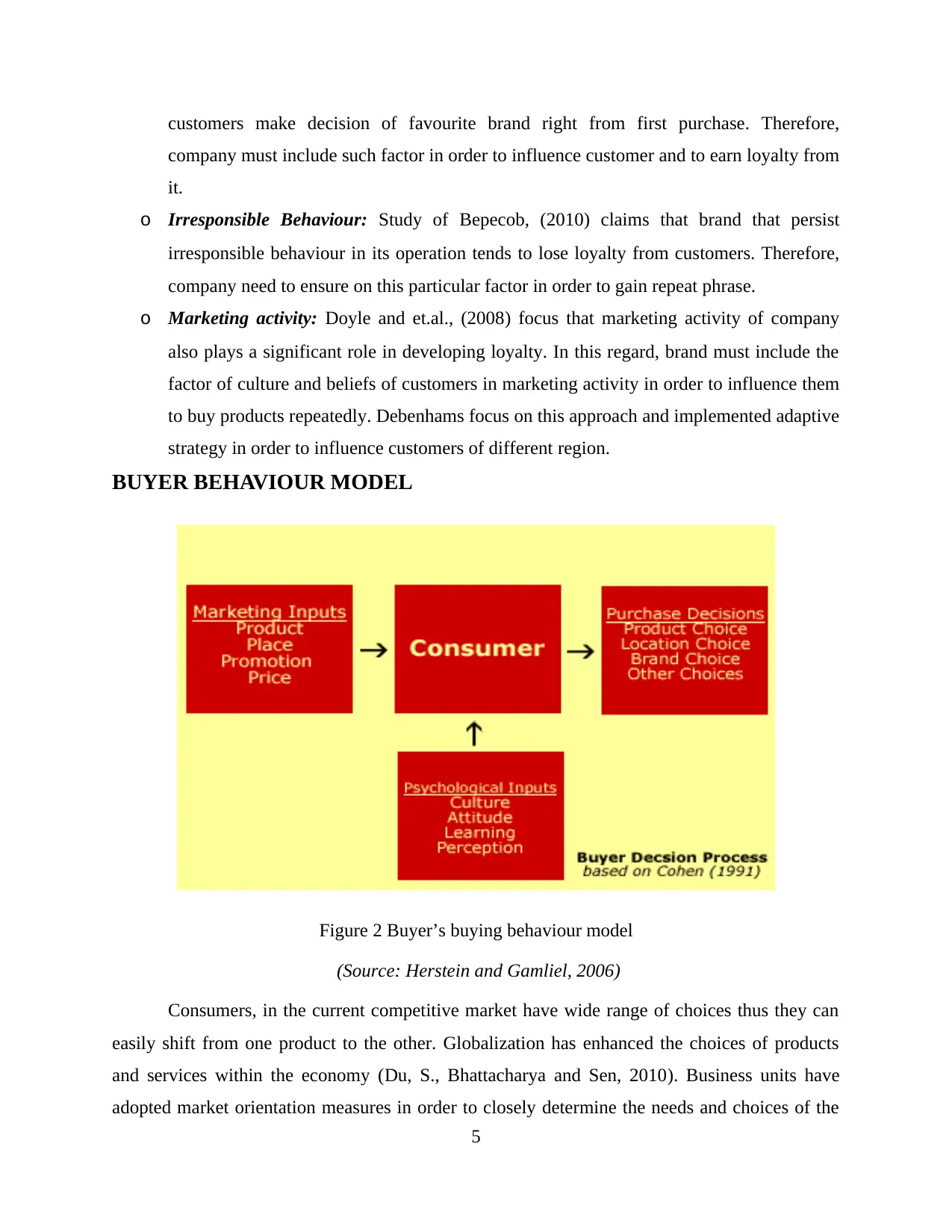
customers make decision of favourite brand right from first purchase. Therefore,
company must include such factor in order to influence customer and to earn loyalty from
it.
o Irresponsible Behaviour: Study of Bерecob, (2010) claims that brand that persist
irresponsible behaviour in its operation tends to lose loyalty from customers. Therefore,
company need to ensure on this particular factor in order to gain repeat phrase.
o Marketing activity: Doyle and et.al., (2008) focus that marketing activity of company
also plays a significant role in developing loyalty. In this regard, brand must include the
factor of culture and beliefs of customers in marketing activity in order to influence them
to buy products repeatedly. Debenhams focus on this approach and implemented adaptive
strategy in order to influence customers of different region.
BUYER BEHAVIOUR MODEL
Figure 2 Buyer’s buying behaviour model
(Source: Herstein and Gamliel, 2006)
Consumers, in the current competitive market have wide range of choices thus they can
easily shift from one product to the other. Globalization has enhanced the choices of products
and services within the economy (Du, S., Bhattacharya and Sen, 2010). Business units have
adopted market orientation measures in order to closely determine the needs and choices of the
5
company must include such factor in order to influence customer and to earn loyalty from
it.
o Irresponsible Behaviour: Study of Bерecob, (2010) claims that brand that persist
irresponsible behaviour in its operation tends to lose loyalty from customers. Therefore,
company need to ensure on this particular factor in order to gain repeat phrase.
o Marketing activity: Doyle and et.al., (2008) focus that marketing activity of company
also plays a significant role in developing loyalty. In this regard, brand must include the
factor of culture and beliefs of customers in marketing activity in order to influence them
to buy products repeatedly. Debenhams focus on this approach and implemented adaptive
strategy in order to influence customers of different region.
BUYER BEHAVIOUR MODEL
Figure 2 Buyer’s buying behaviour model
(Source: Herstein and Gamliel, 2006)
Consumers, in the current competitive market have wide range of choices thus they can
easily shift from one product to the other. Globalization has enhanced the choices of products
and services within the economy (Du, S., Bhattacharya and Sen, 2010). Business units have
adopted market orientation measures in order to closely determine the needs and choices of the
5
Paraphrase This Document
Need a fresh take? Get an instant paraphrase of this document with our AI Paraphraser
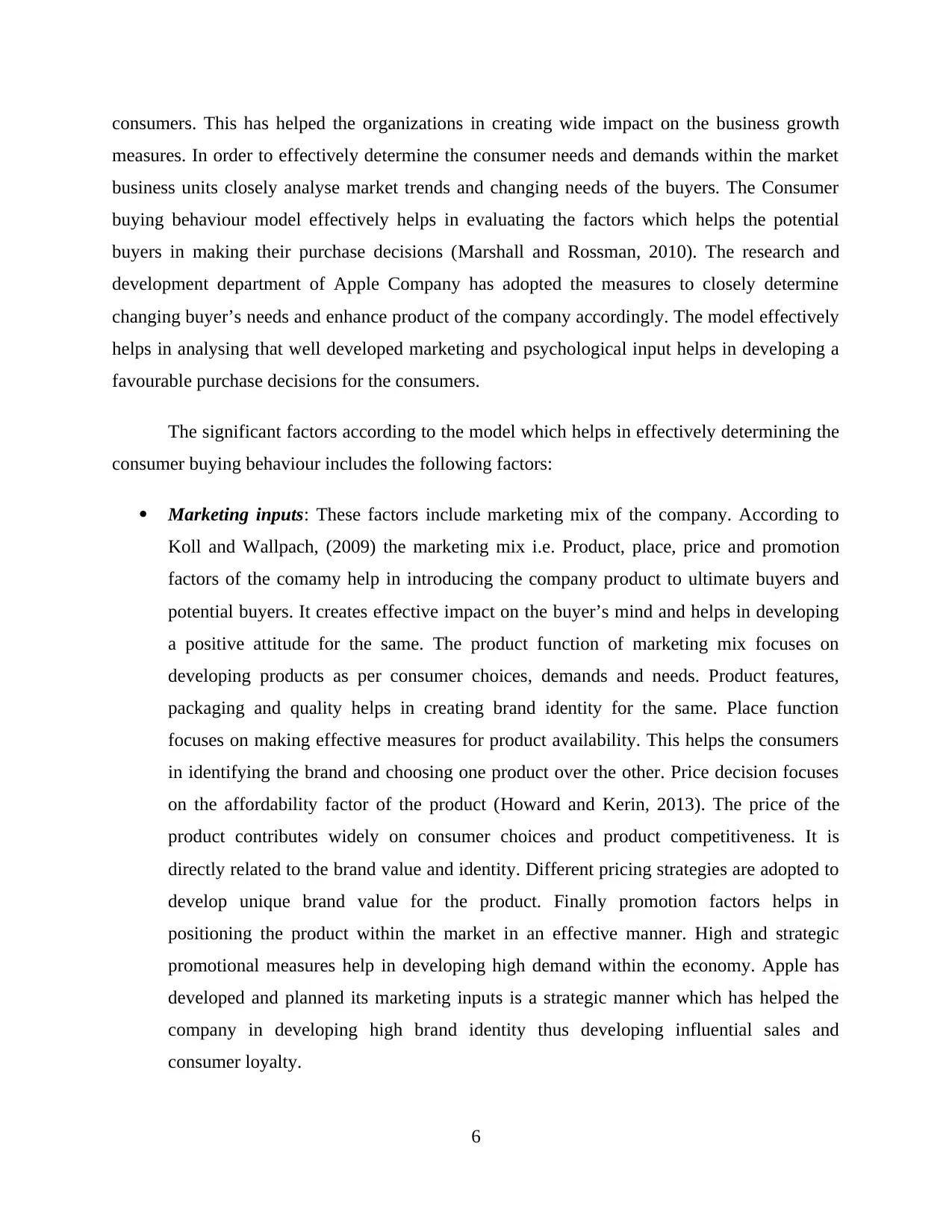
consumers. This has helped the organizations in creating wide impact on the business growth
measures. In order to effectively determine the consumer needs and demands within the market
business units closely analyse market trends and changing needs of the buyers. The Consumer
buying behaviour model effectively helps in evaluating the factors which helps the potential
buyers in making their purchase decisions (Marshall and Rossman, 2010). The research and
development department of Apple Company has adopted the measures to closely determine
changing buyer’s needs and enhance product of the company accordingly. The model effectively
helps in analysing that well developed marketing and psychological input helps in developing a
favourable purchase decisions for the consumers.
The significant factors according to the model which helps in effectively determining the
consumer buying behaviour includes the following factors:
Marketing inputs: These factors include marketing mix of the company. According to
Koll and Wallpach, (2009) the marketing mix i.e. Product, place, price and promotion
factors of the comamy help in introducing the company product to ultimate buyers and
potential buyers. It creates effective impact on the buyer’s mind and helps in developing
a positive attitude for the same. The product function of marketing mix focuses on
developing products as per consumer choices, demands and needs. Product features,
packaging and quality helps in creating brand identity for the same. Place function
focuses on making effective measures for product availability. This helps the consumers
in identifying the brand and choosing one product over the other. Price decision focuses
on the affordability factor of the product (Howard and Kerin, 2013). The price of the
product contributes widely on consumer choices and product competitiveness. It is
directly related to the brand value and identity. Different pricing strategies are adopted to
develop unique brand value for the product. Finally promotion factors helps in
positioning the product within the market in an effective manner. High and strategic
promotional measures help in developing high demand within the economy. Apple has
developed and planned its marketing inputs is a strategic manner which has helped the
company in developing high brand identity thus developing influential sales and
consumer loyalty.
6
measures. In order to effectively determine the consumer needs and demands within the market
business units closely analyse market trends and changing needs of the buyers. The Consumer
buying behaviour model effectively helps in evaluating the factors which helps the potential
buyers in making their purchase decisions (Marshall and Rossman, 2010). The research and
development department of Apple Company has adopted the measures to closely determine
changing buyer’s needs and enhance product of the company accordingly. The model effectively
helps in analysing that well developed marketing and psychological input helps in developing a
favourable purchase decisions for the consumers.
The significant factors according to the model which helps in effectively determining the
consumer buying behaviour includes the following factors:
Marketing inputs: These factors include marketing mix of the company. According to
Koll and Wallpach, (2009) the marketing mix i.e. Product, place, price and promotion
factors of the comamy help in introducing the company product to ultimate buyers and
potential buyers. It creates effective impact on the buyer’s mind and helps in developing
a positive attitude for the same. The product function of marketing mix focuses on
developing products as per consumer choices, demands and needs. Product features,
packaging and quality helps in creating brand identity for the same. Place function
focuses on making effective measures for product availability. This helps the consumers
in identifying the brand and choosing one product over the other. Price decision focuses
on the affordability factor of the product (Howard and Kerin, 2013). The price of the
product contributes widely on consumer choices and product competitiveness. It is
directly related to the brand value and identity. Different pricing strategies are adopted to
develop unique brand value for the product. Finally promotion factors helps in
positioning the product within the market in an effective manner. High and strategic
promotional measures help in developing high demand within the economy. Apple has
developed and planned its marketing inputs is a strategic manner which has helped the
company in developing high brand identity thus developing influential sales and
consumer loyalty.
6

Psychological inputs: These are internal factors which help in creating a psychological
impact on the choices and needs of the buyers widely. These include cultural factors,
attitude, perception and learning of the consumers. Cultural factors deals with the issues
such as impact of social class, sub classes, friends etc. Impact of social influence is high
and effective of the consumer choices. According to Ghodeswar (2008) cultural factors
influence the need of the product and widely help companies in enhancing sales within
the market. For example cultural influence for Apple products is wide in the market
hence every consumer who needs a technologically advanced electronic product first
prefers Apple products. Attitude is yet another factor which helps the companies in
enhancing individual influence (Jara and Cliquet, 2012). It focuses on developing the
need of the product by developing positive attitude for the product through effective
promotional measures. For example attitude for organic food has gradually increased
within the market due to positive influence for the same within the economy. Perception
and learning are the individual factors which are deliberately enhanced through effective
influence and proper information search. All these measures help consumers in
developing a positive impact on buying decisions.
IMPACT OF BRAND IMAGE ON BUYER BEHAVIOUR
7
impact on the choices and needs of the buyers widely. These include cultural factors,
attitude, perception and learning of the consumers. Cultural factors deals with the issues
such as impact of social class, sub classes, friends etc. Impact of social influence is high
and effective of the consumer choices. According to Ghodeswar (2008) cultural factors
influence the need of the product and widely help companies in enhancing sales within
the market. For example cultural influence for Apple products is wide in the market
hence every consumer who needs a technologically advanced electronic product first
prefers Apple products. Attitude is yet another factor which helps the companies in
enhancing individual influence (Jara and Cliquet, 2012). It focuses on developing the
need of the product by developing positive attitude for the product through effective
promotional measures. For example attitude for organic food has gradually increased
within the market due to positive influence for the same within the economy. Perception
and learning are the individual factors which are deliberately enhanced through effective
influence and proper information search. All these measures help consumers in
developing a positive impact on buying decisions.
IMPACT OF BRAND IMAGE ON BUYER BEHAVIOUR
7
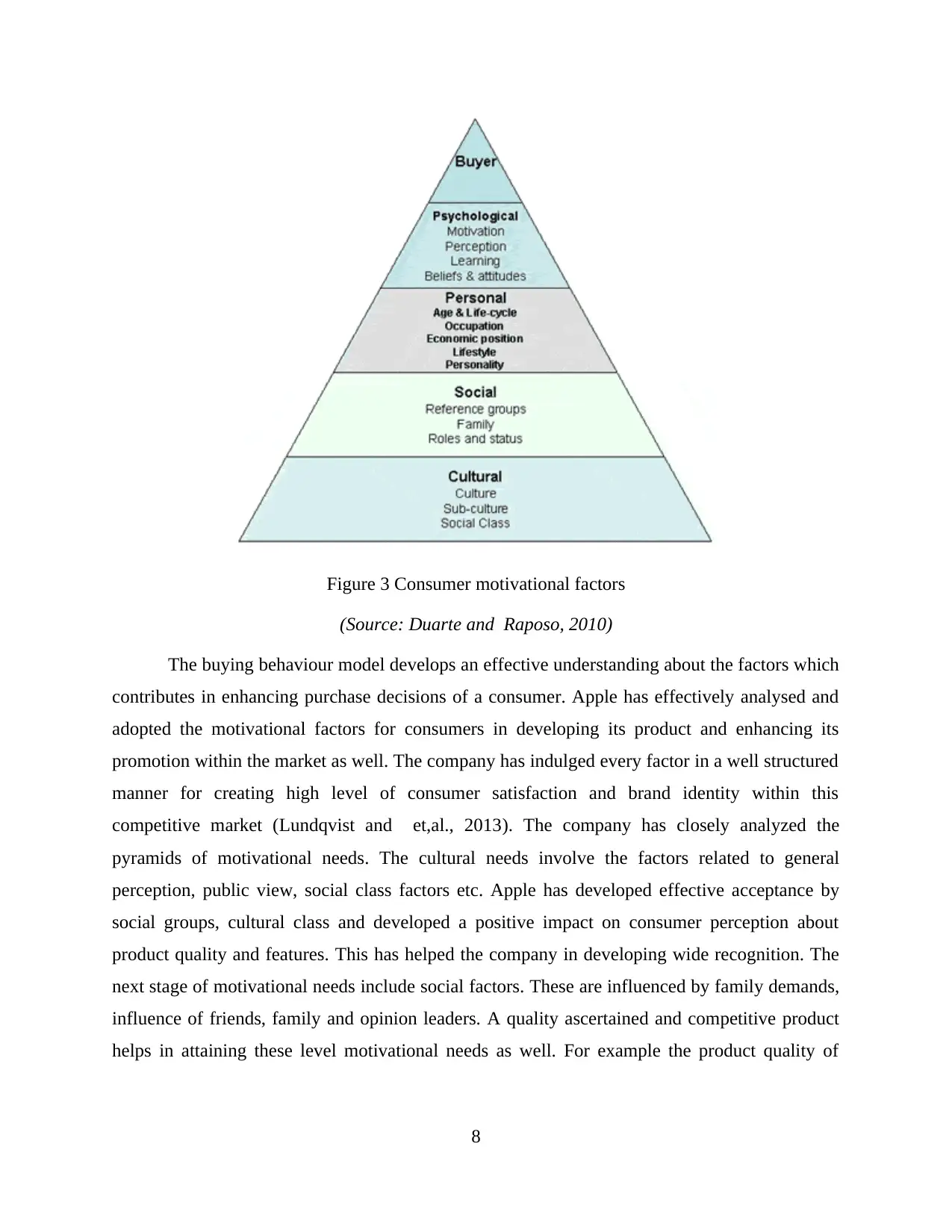
Figure 3 Consumer motivational factors
(Source: Duarte and Raposo, 2010)
The buying behaviour model develops an effective understanding about the factors which
contributes in enhancing purchase decisions of a consumer. Apple has effectively analysed and
adopted the motivational factors for consumers in developing its product and enhancing its
promotion within the market as well. The company has indulged every factor in a well structured
manner for creating high level of consumer satisfaction and brand identity within this
competitive market (Lundqvist and et,al., 2013). The company has closely analyzed the
pyramids of motivational needs. The cultural needs involve the factors related to general
perception, public view, social class factors etc. Apple has developed effective acceptance by
social groups, cultural class and developed a positive impact on consumer perception about
product quality and features. This has helped the company in developing wide recognition. The
next stage of motivational needs include social factors. These are influenced by family demands,
influence of friends, family and opinion leaders. A quality ascertained and competitive product
helps in attaining these level motivational needs as well. For example the product quality of
8
(Source: Duarte and Raposo, 2010)
The buying behaviour model develops an effective understanding about the factors which
contributes in enhancing purchase decisions of a consumer. Apple has effectively analysed and
adopted the motivational factors for consumers in developing its product and enhancing its
promotion within the market as well. The company has indulged every factor in a well structured
manner for creating high level of consumer satisfaction and brand identity within this
competitive market (Lundqvist and et,al., 2013). The company has closely analyzed the
pyramids of motivational needs. The cultural needs involve the factors related to general
perception, public view, social class factors etc. Apple has developed effective acceptance by
social groups, cultural class and developed a positive impact on consumer perception about
product quality and features. This has helped the company in developing wide recognition. The
next stage of motivational needs include social factors. These are influenced by family demands,
influence of friends, family and opinion leaders. A quality ascertained and competitive product
helps in attaining these level motivational needs as well. For example the product quality of
8
Secure Best Marks with AI Grader
Need help grading? Try our AI Grader for instant feedback on your assignments.
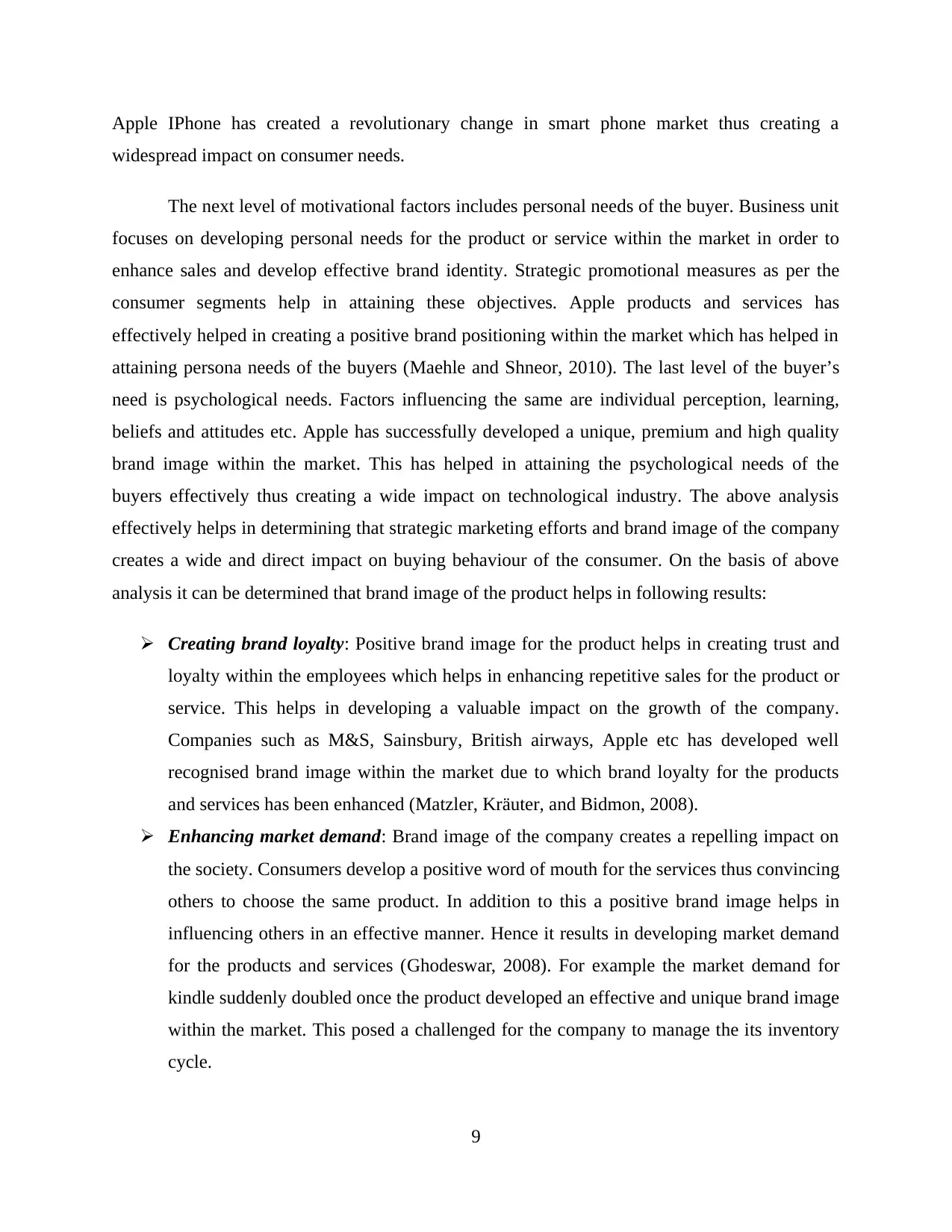
Apple IPhone has created a revolutionary change in smart phone market thus creating a
widespread impact on consumer needs.
The next level of motivational factors includes personal needs of the buyer. Business unit
focuses on developing personal needs for the product or service within the market in order to
enhance sales and develop effective brand identity. Strategic promotional measures as per the
consumer segments help in attaining these objectives. Apple products and services has
effectively helped in creating a positive brand positioning within the market which has helped in
attaining persona needs of the buyers (Maehle and Shneor, 2010). The last level of the buyer’s
need is psychological needs. Factors influencing the same are individual perception, learning,
beliefs and attitudes etc. Apple has successfully developed a unique, premium and high quality
brand image within the market. This has helped in attaining the psychological needs of the
buyers effectively thus creating a wide impact on technological industry. The above analysis
effectively helps in determining that strategic marketing efforts and brand image of the company
creates a wide and direct impact on buying behaviour of the consumer. On the basis of above
analysis it can be determined that brand image of the product helps in following results:
Creating brand loyalty: Positive brand image for the product helps in creating trust and
loyalty within the employees which helps in enhancing repetitive sales for the product or
service. This helps in developing a valuable impact on the growth of the company.
Companies such as M&S, Sainsbury, British airways, Apple etc has developed well
recognised brand image within the market due to which brand loyalty for the products
and services has been enhanced (Matzler, Kräuter, and Bidmon, 2008).
Enhancing market demand: Brand image of the company creates a repelling impact on
the society. Consumers develop a positive word of mouth for the services thus convincing
others to choose the same product. In addition to this a positive brand image helps in
influencing others in an effective manner. Hence it results in developing market demand
for the products and services (Ghodeswar, 2008). For example the market demand for
kindle suddenly doubled once the product developed an effective and unique brand image
within the market. This posed a challenged for the company to manage the its inventory
cycle.
9
widespread impact on consumer needs.
The next level of motivational factors includes personal needs of the buyer. Business unit
focuses on developing personal needs for the product or service within the market in order to
enhance sales and develop effective brand identity. Strategic promotional measures as per the
consumer segments help in attaining these objectives. Apple products and services has
effectively helped in creating a positive brand positioning within the market which has helped in
attaining persona needs of the buyers (Maehle and Shneor, 2010). The last level of the buyer’s
need is psychological needs. Factors influencing the same are individual perception, learning,
beliefs and attitudes etc. Apple has successfully developed a unique, premium and high quality
brand image within the market. This has helped in attaining the psychological needs of the
buyers effectively thus creating a wide impact on technological industry. The above analysis
effectively helps in determining that strategic marketing efforts and brand image of the company
creates a wide and direct impact on buying behaviour of the consumer. On the basis of above
analysis it can be determined that brand image of the product helps in following results:
Creating brand loyalty: Positive brand image for the product helps in creating trust and
loyalty within the employees which helps in enhancing repetitive sales for the product or
service. This helps in developing a valuable impact on the growth of the company.
Companies such as M&S, Sainsbury, British airways, Apple etc has developed well
recognised brand image within the market due to which brand loyalty for the products
and services has been enhanced (Matzler, Kräuter, and Bidmon, 2008).
Enhancing market demand: Brand image of the company creates a repelling impact on
the society. Consumers develop a positive word of mouth for the services thus convincing
others to choose the same product. In addition to this a positive brand image helps in
influencing others in an effective manner. Hence it results in developing market demand
for the products and services (Ghodeswar, 2008). For example the market demand for
kindle suddenly doubled once the product developed an effective and unique brand image
within the market. This posed a challenged for the company to manage the its inventory
cycle.
9
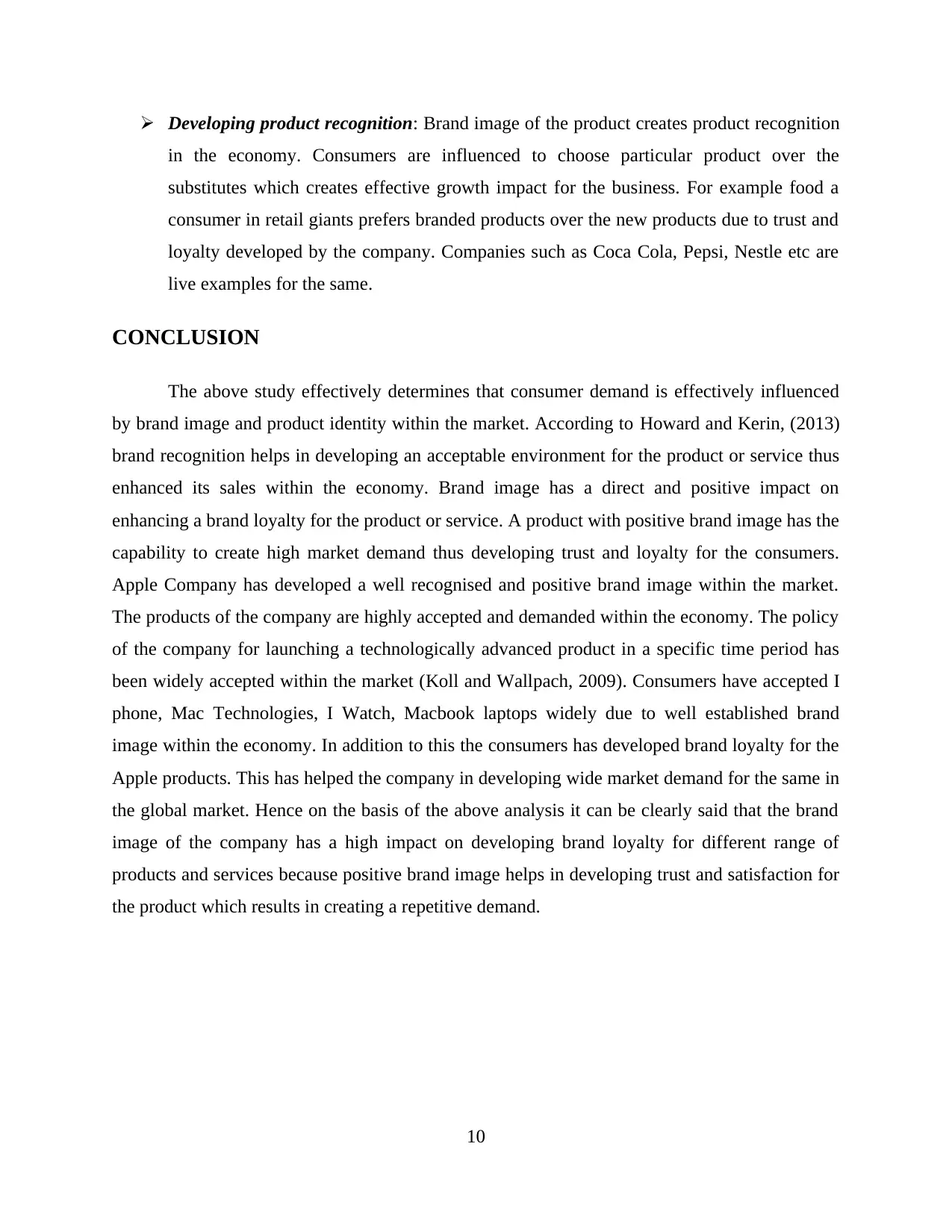
Developing product recognition: Brand image of the product creates product recognition
in the economy. Consumers are influenced to choose particular product over the
substitutes which creates effective growth impact for the business. For example food a
consumer in retail giants prefers branded products over the new products due to trust and
loyalty developed by the company. Companies such as Coca Cola, Pepsi, Nestle etc are
live examples for the same.
CONCLUSION
The above study effectively determines that consumer demand is effectively influenced
by brand image and product identity within the market. According to Howard and Kerin, (2013)
brand recognition helps in developing an acceptable environment for the product or service thus
enhanced its sales within the economy. Brand image has a direct and positive impact on
enhancing a brand loyalty for the product or service. A product with positive brand image has the
capability to create high market demand thus developing trust and loyalty for the consumers.
Apple Company has developed a well recognised and positive brand image within the market.
The products of the company are highly accepted and demanded within the economy. The policy
of the company for launching a technologically advanced product in a specific time period has
been widely accepted within the market (Koll and Wallpach, 2009). Consumers have accepted I
phone, Mac Technologies, I Watch, Macbook laptops widely due to well established brand
image within the economy. In addition to this the consumers has developed brand loyalty for the
Apple products. This has helped the company in developing wide market demand for the same in
the global market. Hence on the basis of the above analysis it can be clearly said that the brand
image of the company has a high impact on developing brand loyalty for different range of
products and services because positive brand image helps in developing trust and satisfaction for
the product which results in creating a repetitive demand.
10
in the economy. Consumers are influenced to choose particular product over the
substitutes which creates effective growth impact for the business. For example food a
consumer in retail giants prefers branded products over the new products due to trust and
loyalty developed by the company. Companies such as Coca Cola, Pepsi, Nestle etc are
live examples for the same.
CONCLUSION
The above study effectively determines that consumer demand is effectively influenced
by brand image and product identity within the market. According to Howard and Kerin, (2013)
brand recognition helps in developing an acceptable environment for the product or service thus
enhanced its sales within the economy. Brand image has a direct and positive impact on
enhancing a brand loyalty for the product or service. A product with positive brand image has the
capability to create high market demand thus developing trust and loyalty for the consumers.
Apple Company has developed a well recognised and positive brand image within the market.
The products of the company are highly accepted and demanded within the economy. The policy
of the company for launching a technologically advanced product in a specific time period has
been widely accepted within the market (Koll and Wallpach, 2009). Consumers have accepted I
phone, Mac Technologies, I Watch, Macbook laptops widely due to well established brand
image within the economy. In addition to this the consumers has developed brand loyalty for the
Apple products. This has helped the company in developing wide market demand for the same in
the global market. Hence on the basis of the above analysis it can be clearly said that the brand
image of the company has a high impact on developing brand loyalty for different range of
products and services because positive brand image helps in developing trust and satisfaction for
the product which results in creating a repetitive demand.
10

REFERENCES
Aaker, A. D. and McLoughlin, D., 2009. Strategic Market Management: Global Perspectives.
John Wiley & Sons.
Aaker, D. A., 2012. Building strong brands. Simon and Schuster.
Arslan, M. F. and Altuna, K. O., 2010.The effect of brand extensions on product brand image.
Journal of Product & Brand Management. 19(3).pp.170 – 180.
Becerra, P. E. and Badrinarayanan, V., 2013.The influence of brand trust and brand identification
on brand evangelism. Journal of Product & Brand Management. 22(5/6). pp.371 – 383.
Beverland, M., 2005.Brand management and the challenge of authenticity. Journal of Product &
Brand Management. 14(7).pp.460 – 461.
Bick, G. N., 2009. Increasing shareholder value through building customer and brand
equity.Journal of Marketing Management. 25(1-2). pp. 117-141.
Brown, D. and Fiorella, S., 2013.Influence Marketing: How to Create, Manage, and Measure
Brand Influencers in Social Media Marketing. Que Publishing.
Butler, T., 2011. Compliance with institutional imperatives on environmental sustainability:
Building theory on the role of Green IS. The Journal of Strategic Information Systems.
20(1). pp. 6-26.
Bерecob, Н. Н., 2010. Introducing cultural historical theory: main concepts and principles of
genetic research methodology.Культурно-историческаяпсихология.2010(4). pp. 83-90.
Chen, J. K. and Liu, C., 2004. Positive brand extension trial and choice of parent brand. Journal
of Product & Brand Management. 13(1).pp.25 – 36.
Delassus, P. V. and Descotes, M. R., 2012. Brand name substitution and brand equity transfer.
Journal of Product & Brand Management. 21(2).pp.117 – 125.
Doyle, S. A., and et.al., 2008. Brand context and control: the role of the flagship store in B&B
Italia. International Journal of Retail & Distribution Management. 36(7). pp. 551-563.
Du, S., Bhattacharya, C. B. and Sen, S., 2010. Maximizing business returns to corporate social
responsibility (CSR): The role of CSR communication.International Journal of
Management Reviews.12(1). pp. 8-19.
Duarte, P. A. O. and Raposo, M. L. B., 2010. A PLS model to study brand preference: An
application to the mobile phone market. In Handbook of partial least squares.pp. 449-
485. Springer Berlin Heidelberg.
Ghodeswar, B. M., 2008. Building brand identity in competitive markets: a conceptual model.
Journal of Product & Brand Management.17(1). pp. 4-12.
Herstein, R. and Gamliel, E., 2006. The role of private branding in improving service
quality.Managing Service Quality: An International Journal.16(3). Pp. 306-319.
Howard, D. and Kerin, R., 2013. A surname brand effect explanation for consumer brand
preference and advocacy. Journal of Product & Brand Management. 22(5/6). pp.362 –
370.
11
Aaker, A. D. and McLoughlin, D., 2009. Strategic Market Management: Global Perspectives.
John Wiley & Sons.
Aaker, D. A., 2012. Building strong brands. Simon and Schuster.
Arslan, M. F. and Altuna, K. O., 2010.The effect of brand extensions on product brand image.
Journal of Product & Brand Management. 19(3).pp.170 – 180.
Becerra, P. E. and Badrinarayanan, V., 2013.The influence of brand trust and brand identification
on brand evangelism. Journal of Product & Brand Management. 22(5/6). pp.371 – 383.
Beverland, M., 2005.Brand management and the challenge of authenticity. Journal of Product &
Brand Management. 14(7).pp.460 – 461.
Bick, G. N., 2009. Increasing shareholder value through building customer and brand
equity.Journal of Marketing Management. 25(1-2). pp. 117-141.
Brown, D. and Fiorella, S., 2013.Influence Marketing: How to Create, Manage, and Measure
Brand Influencers in Social Media Marketing. Que Publishing.
Butler, T., 2011. Compliance with institutional imperatives on environmental sustainability:
Building theory on the role of Green IS. The Journal of Strategic Information Systems.
20(1). pp. 6-26.
Bерecob, Н. Н., 2010. Introducing cultural historical theory: main concepts and principles of
genetic research methodology.Культурно-историческаяпсихология.2010(4). pp. 83-90.
Chen, J. K. and Liu, C., 2004. Positive brand extension trial and choice of parent brand. Journal
of Product & Brand Management. 13(1).pp.25 – 36.
Delassus, P. V. and Descotes, M. R., 2012. Brand name substitution and brand equity transfer.
Journal of Product & Brand Management. 21(2).pp.117 – 125.
Doyle, S. A., and et.al., 2008. Brand context and control: the role of the flagship store in B&B
Italia. International Journal of Retail & Distribution Management. 36(7). pp. 551-563.
Du, S., Bhattacharya, C. B. and Sen, S., 2010. Maximizing business returns to corporate social
responsibility (CSR): The role of CSR communication.International Journal of
Management Reviews.12(1). pp. 8-19.
Duarte, P. A. O. and Raposo, M. L. B., 2010. A PLS model to study brand preference: An
application to the mobile phone market. In Handbook of partial least squares.pp. 449-
485. Springer Berlin Heidelberg.
Ghodeswar, B. M., 2008. Building brand identity in competitive markets: a conceptual model.
Journal of Product & Brand Management.17(1). pp. 4-12.
Herstein, R. and Gamliel, E., 2006. The role of private branding in improving service
quality.Managing Service Quality: An International Journal.16(3). Pp. 306-319.
Howard, D. and Kerin, R., 2013. A surname brand effect explanation for consumer brand
preference and advocacy. Journal of Product & Brand Management. 22(5/6). pp.362 –
370.
11
Paraphrase This Document
Need a fresh take? Get an instant paraphrase of this document with our AI Paraphraser
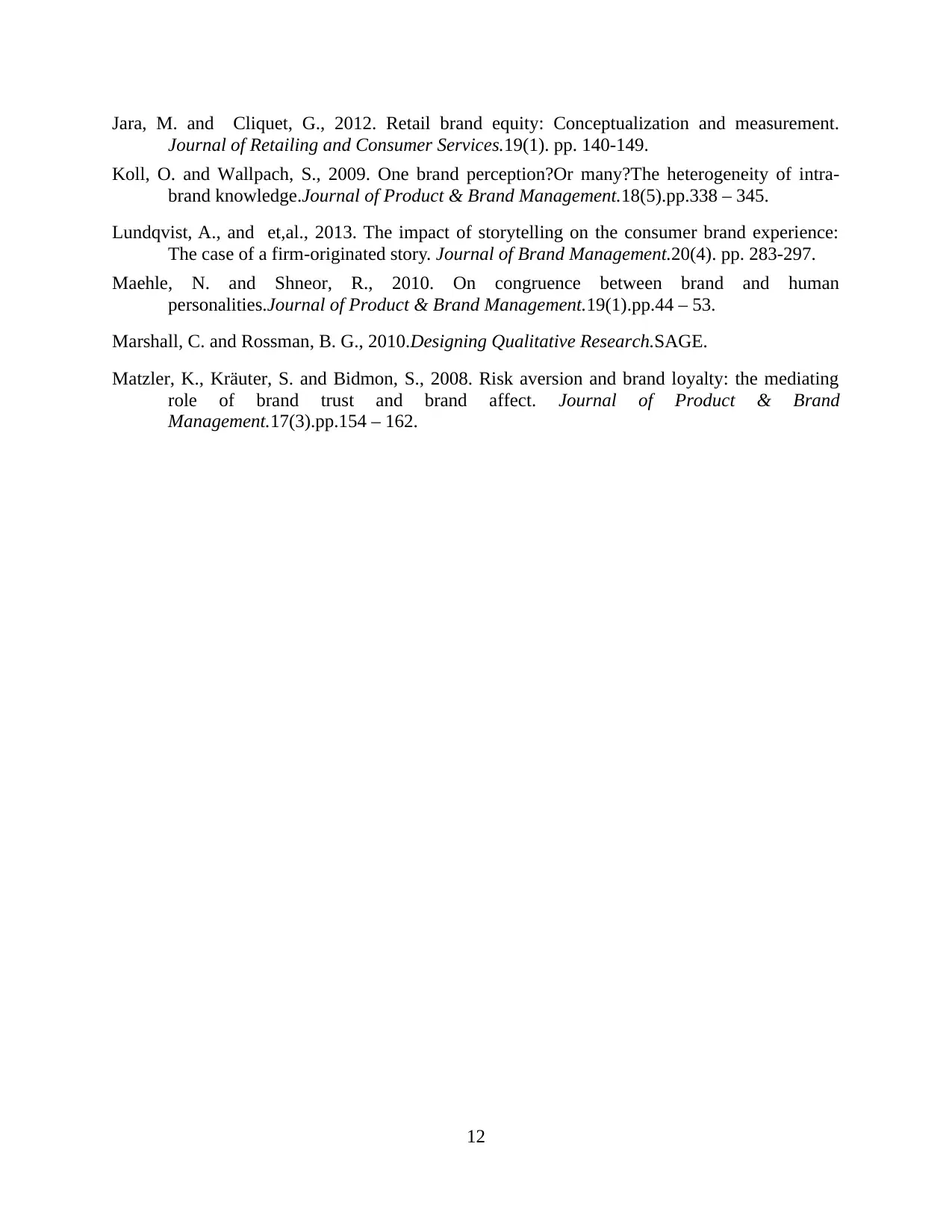
Jara, M. and Cliquet, G., 2012. Retail brand equity: Conceptualization and measurement.
Journal of Retailing and Consumer Services.19(1). pp. 140-149.
Koll, O. and Wallpach, S., 2009. One brand perception?Or many?The heterogeneity of intra-
brand knowledge.Journal of Product & Brand Management.18(5).pp.338 – 345.
Lundqvist, A., and et,al., 2013. The impact of storytelling on the consumer brand experience:
The case of a firm-originated story. Journal of Brand Management.20(4). pp. 283-297.
Maehle, N. and Shneor, R., 2010. On congruence between brand and human
personalities.Journal of Product & Brand Management.19(1).pp.44 – 53.
Marshall, C. and Rossman, B. G., 2010.Designing Qualitative Research.SAGE.
Matzler, K., Kräuter, S. and Bidmon, S., 2008. Risk aversion and brand loyalty: the mediating
role of brand trust and brand affect. Journal of Product & Brand
Management.17(3).pp.154 – 162.
12
Journal of Retailing and Consumer Services.19(1). pp. 140-149.
Koll, O. and Wallpach, S., 2009. One brand perception?Or many?The heterogeneity of intra-
brand knowledge.Journal of Product & Brand Management.18(5).pp.338 – 345.
Lundqvist, A., and et,al., 2013. The impact of storytelling on the consumer brand experience:
The case of a firm-originated story. Journal of Brand Management.20(4). pp. 283-297.
Maehle, N. and Shneor, R., 2010. On congruence between brand and human
personalities.Journal of Product & Brand Management.19(1).pp.44 – 53.
Marshall, C. and Rossman, B. G., 2010.Designing Qualitative Research.SAGE.
Matzler, K., Kräuter, S. and Bidmon, S., 2008. Risk aversion and brand loyalty: the mediating
role of brand trust and brand affect. Journal of Product & Brand
Management.17(3).pp.154 – 162.
12
1 out of 14
Related Documents
Your All-in-One AI-Powered Toolkit for Academic Success.
+13062052269
info@desklib.com
Available 24*7 on WhatsApp / Email
![[object Object]](/_next/static/media/star-bottom.7253800d.svg)
Unlock your academic potential
© 2024 | Zucol Services PVT LTD | All rights reserved.





